| Listing 1 - 10 of 59 | << page >> |
Sort by
|
Book
ISBN: 9782718608525 2718608528 Year: 2011 Volume: *31 Publisher: Paris: Galilée,
Abstract | Keywords | Export | Availability | Bookmark
 Loading...
Loading...Choose an application
- Reference Manager
- EndNote
- RefWorks (Direct export to RefWorks)
Du Torse du Belvédère analysé par Winckelmann au décor des métayers de l’Alabama décrit par James Agee, en passant par une visite de Hegel au musée, une conférence d’Emerson à Boston, une soirée de Mallarmé aux Folies-Bergère, une exposition à Paris ou New York, une mise en scène à Moscou ou la construction d’une usine à Berlin, Jacques Rancière examine une quinzaine d’événements ou de moments, célèbres ou obscurs, où l’on se demande ce qui fait l’art et ce qu’il fait. À travers ces épisodes on voit un régime de perception et d’interprétation de l’art se constituer et se transformer en effaçant les spécificités des arts et les frontières qui les séparaient de l’expérience ordinaire. On apprend comment une statue mutilée peut devenir une oeuvre parfaite, une image d’enfants pouilleux une représentation de l’idéal, une culbute de clowns l’envol dans le ciel poétique, un meuble un temple, un escalier un personnage, une salopette rapiécée un habit de prince, les circonvolutions d’un voile une cosmogonie, et un montage accéléré de gestes la réalité sensible du communisme : une histoire de la modernité artistique bien éloignée du dogme moderniste.
Aesthetics --- Esthétique --- Théorie de l'art --- Analyse de l'art --- Aesthetics, Modern --- Art --- Philosophie --- Aspect social --- Modern aesthetics --- Aspect social.
Multi
ISBN: 9781107643222 9781107038035 9781107038042 9781107038059 1107643228 1107038030 1107038049 1107038057 9781107110342 1107110343 Year: 2014 Publisher: Cambridge [etc.] Cambridge University Press
Abstract | Keywords | Export | Availability | Bookmark
 Loading...
Loading...Choose an application
- Reference Manager
- EndNote
- RefWorks (Direct export to RefWorks)
A History of Modern Aesthetics narrates the history of philosophical aesthetics from the beginning of the eighteenth century through the twentieth century. Aesthetics began with Aristotle's defense of the cognitive value of tragedy in response to Plato's famous attack on the arts in The Republic, and cognitivist accounts of aesthetic experience have been central to the field ever since. But in the eighteenth century, two new ideas were introduced: that aesthetic experience is important because of emotional impact - precisely what Plato criticized - and because it is a pleasurable free play of many or all of our mental powers. This book tells how these ideas have been synthesized or separated by both the best-known and lesser-known aestheticians of modern times, focusing on Britain, France and Germany in the eighteenth century; Germany and Britain in the nineteenth; and Germany, Britain and the United States in the twentieth.
Aesthetics --- anno 1700-1799 --- anno 1800-1999 --- Aesthetics, Modern --- Aesthetics, Modern. --- PHILOSOPHY --- History. --- History & Surveys --- Modern. --- Modern aesthetics --- History --- Philosophy
Book
ISBN: 9028923055 9039106940 Year: 1996 Volume: *7 Publisher: Kampen Kapellen Kok Agora Pelckmans
Abstract | Keywords | Export | Availability | Bookmark
 Loading...
Loading...Choose an application
- Reference Manager
- EndNote
- RefWorks (Direct export to RefWorks)
Epistémologie --- Geschiedenis --- Histoire --- Kennisleer --- Aesthetics, Modern. --- Culture --- Political culture. --- Philosophy. --- Aesthetics, Modern --- Political culture --- Political science --- Modern aesthetics --- Philosophy --- Philosophy and psychology of culture --- Aesthetics --- geschiedenisfilosofie
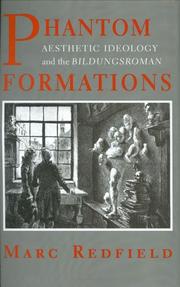
ISBN: 0801432367 9780801432361 1501723189 1501723170 9781501723179 1501723162 9781501723162 Year: 2018 Publisher: Cornell University Press
Abstract | Keywords | Export | Availability | Bookmark
 Loading...
Loading...Choose an application
- Reference Manager
- EndNote
- RefWorks (Direct export to RefWorks)
Marc Redfield maintains that the literary genre of the Bildungsroman brings into sharp focus the contradictions of aesthetics, and also that aesthetics exemplifies what is called ideology. He combines a wide-ranging account of the history and theory of aesthetics with close readings of novels by Goethe, George Eliot, and Gustave Flaubert. For Redfield, these fictions of character formation demonstrate the paradoxical relation between aesthetics and literature: the notion of the Bildungsroman may be expanded to apply to any text that can be figured as a subject producing itself in history, which is to say any text whatsoever. At the same time, the category may be contracted to include only a handful of novels, (or even none at all), a paradox that has led critics to denigrate the Bildungsroman as a phantom genre.
Aesthetics [Modern ] --- Bildungsroman --- Esthetica (Moderne filosofie) --- Esthetica [Moderne ] --- Esthétique (Philosophie moderne) --- Esthétique moderne --- Modern aesthetics --- Moderne esthetica --- Roman éducatif --- Aesthetics, Modern. --- Bildungsromans --- European fiction --- German fiction --- History and criticism. --- Aesthetics, Modern --- History and criticism --- 19th century --- Literature: history & criticism
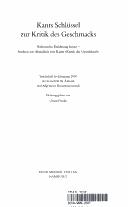
ISBN: 3787315683 Year: 2000 Volume: 1(2000) Publisher: Hamburg Felix Meiner Verlag
Abstract | Keywords | Export | Availability | Bookmark
 Loading...
Loading...Choose an application
- Reference Manager
- EndNote
- RefWorks (Direct export to RefWorks)
Aesthetics [Modern ] --- Esthetica (Moderne filosofie) --- Esthetica [Moderne ] --- Esthétique (Philosophie moderne) --- Esthétique moderne --- Modern aesthetics --- Moderne esthetica --- 1 KANT, IMMANUEL --- Filosofie. Psychologie--KANT, IMMANUEL --- 1 KANT, IMMANUEL Filosofie. Psychologie--KANT, IMMANUEL --- Kant, Immanuel --- Aesthetics
Book
ISBN: 9782874490941 2874490946 Year: 2011 Volume: *19 Publisher: Paris: Les Impressions nouvelles,
Abstract | Keywords | Export | Availability | Bookmark
 Loading...
Loading...Choose an application
- Reference Manager
- EndNote
- RefWorks (Direct export to RefWorks)
En s’accordant aux multiplicités transversales de l’écriture et des opérations réflexives qui lui sont liées, le présent recueil pose le problème du style chez Deleuze suivant trois découpes connexes : entre philosophie et histoire de la philosophie, logique et esthétique, clinique et politique. L’ensemble des études ici réunies ont en commun de référer chaque fois la stylistique deleuzienne à un concept ou un cas d’analyse précis, susceptibles d’en cerner les présupposés théoriques et le mode de fonctionnement. La multiplication des perspectives devrait ainsi permettre de dégager les jalons de ce qui, dans cette pensée en acte, s’offre précisément comme méthode et pratique singulière du style, consignant par là un style de pensée spécifique : le style-Deleuze
Aesthetics --- Aesthetics [Modern ] --- Esthetica --- Esthetica (Moderne filosofie) --- Esthetica [Moderne ] --- Esthétique --- Esthétique (Philosophie moderne) --- Esthétique moderne --- Modern aesthetics --- Moderne esthetica --- Deleuze, Gilles, --- Deleuze, Gilles --- Criticism and interpretation --- Deleuze, Gilles, 1925-1995 --- Style. --- Critique et interprétation.
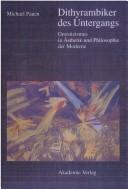
ISBN: 3050026596 3050070595 Year: 1994 Publisher: Berlin Akademie Verlag
Abstract | Keywords | Export | Availability | Bookmark
 Loading...
Loading...Choose an application
- Reference Manager
- EndNote
- RefWorks (Direct export to RefWorks)
Aesthetics [Modern ] --- Esthetica (Moderne filosofie) --- Esthetica [Moderne ] --- Esthétique (Philosophie moderne) --- Esthétique moderne --- Filosofie [Moderne ] --- Gnose --- Gnosis --- Gnosticism --- Gnosticisme --- Modern aesthetics --- Moderne esthetica --- Philosophie moderne --- Philosophy [Modern ] --- Aesthetics, Modern --- Philosophy, Modern --- Modern philosophy --- Europe --- Intellectual life. --- Cults
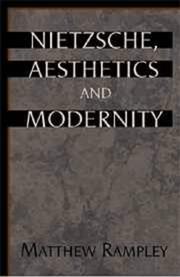
ISBN: 0521651557 052103793X 0511663684 Year: 1999 Publisher: Cambridge, U. K. New York Cambridge University Press
Abstract | Keywords | Export | Availability | Bookmark
 Loading...
Loading...Choose an application
- Reference Manager
- EndNote
- RefWorks (Direct export to RefWorks)
Nietzsche, Aesthetics and Modernity analyses Nietzsche's response to the aesthetic tradition, tracing in particular the complex relationship between the work and thought of Nietzsche, Kant and Hegel. Focusing in particular on the critical role of negation and sublimity in Nietzsche's account of art, it explores his confrontation with modernity and his attempt to posit a revitalized artistic practice as the counter-movement to modern nihilism. Drawing on the full range of his published and unpublished writings, together with his comments on figures as diverse as Wagner, Zola, Delacroix and Laurence Sterne, it highlights the extent to which Nietzsche counters the culture of his own time with a dialectical notion of aesthetic interpretation and practice. As such, Nietzsche the dialectician articulates a position that proves to be intimately connected to the negative dialects of Theodor Adorno.
Aesthetics [Modern ] --- Esthetica (Moderne filosofie) --- Esthetica [Moderne ] --- Esthétique (Philosophie moderne) --- Esthétique moderne --- Modern aesthetics --- Moderne esthetica --- Aesthetics, Modern. --- Nietzsche, Friedrich Wilhelm --- Aesthetics --- Arts and Humanities --- Philosophy --- Nietzsche, Friedrich Wilhelm, --- Aesthetics. --- Nietzsche, Friedrich --- Nietzsche, Friederich
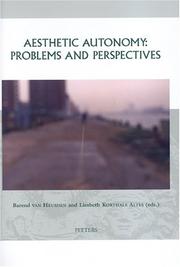
ISBN: 904291579X 9789042915794 Year: 2004 Publisher: Leuven Paris Peeters
Abstract | Keywords | Export | Availability | Bookmark
 Loading...
Loading...Choose an application
- Reference Manager
- EndNote
- RefWorks (Direct export to RefWorks)
Aesthetics, Modern --- Arts, Modern --- Autonomy (Philosophy) --- 82.01 --- 82:3 --- Modern aesthetics --- Philosophy --- Modern arts --- 82:3 Literatuur en maatschappijwetenschappen --- Literatuur en maatschappijwetenschappen --- 82.01 Esthetica --- Esthetica --- Social aspects
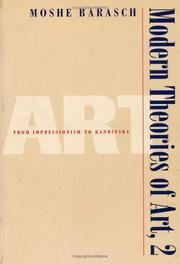
ISBN: 0814711332 9780814711330 0814711766 0814787274 Year: 1990 Volume: 1 Publisher: New York, NY : New York University Press,
Abstract | Keywords | Export | Availability | Bookmark
 Loading...
Loading...Choose an application
- Reference Manager
- EndNote
- RefWorks (Direct export to RefWorks)
This is an analytical survey of the thought about painting and sculpture as it unfolded from the early eighteenth to the mid-nineteenth centuries. This was the period during which theories of the visual arts, particularly of painting and sculpture, underwent a radical transformation, as a result of which the intellectual foundations of our modern views on the arts were formed. Because this transformation can only be understood when seen in a broad context of cultural, aesthetic, and philosophical developments of the period, Moshe Barasch surveys the opinions of the artists, and also treats in some detail the doctrines of philosophers, poets, and critics. Barasch thus traces for the reader the entire development of modernism in art and art theory.
Art --- Aesthetics, Modern --- Philosophy. --- History --- art theory --- -Aesthetics, Modern --- -Art --- -Art, Occidental --- Art, Visual --- Art, Western (Western countries) --- Arts, Fine --- Arts, Visual --- Fine arts --- Iconography --- Occidental art --- Visual arts --- Western art (Western countries) --- Arts --- Aesthetics --- Modern aesthetics --- Philosophy --- Esthétique --- Esthétique moderne --- Philosophie --- -Modern aesthetics --- Art, Occidental --- Beautiful, The --- Beauty --- Art and philosophy --- Analysis, interpretation, appreciation --- Aesthetics [Modern ] --- 18th century --- 19th century --- Aesthetics, Modern. --- History.
| Listing 1 - 10 of 59 | << page >> |
Sort by
|

 Search
Search Feedback
Feedback About UniCat
About UniCat  Help
Help News
News